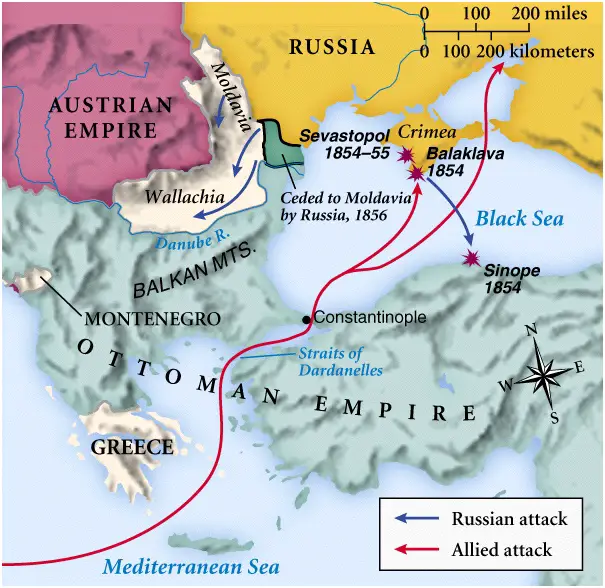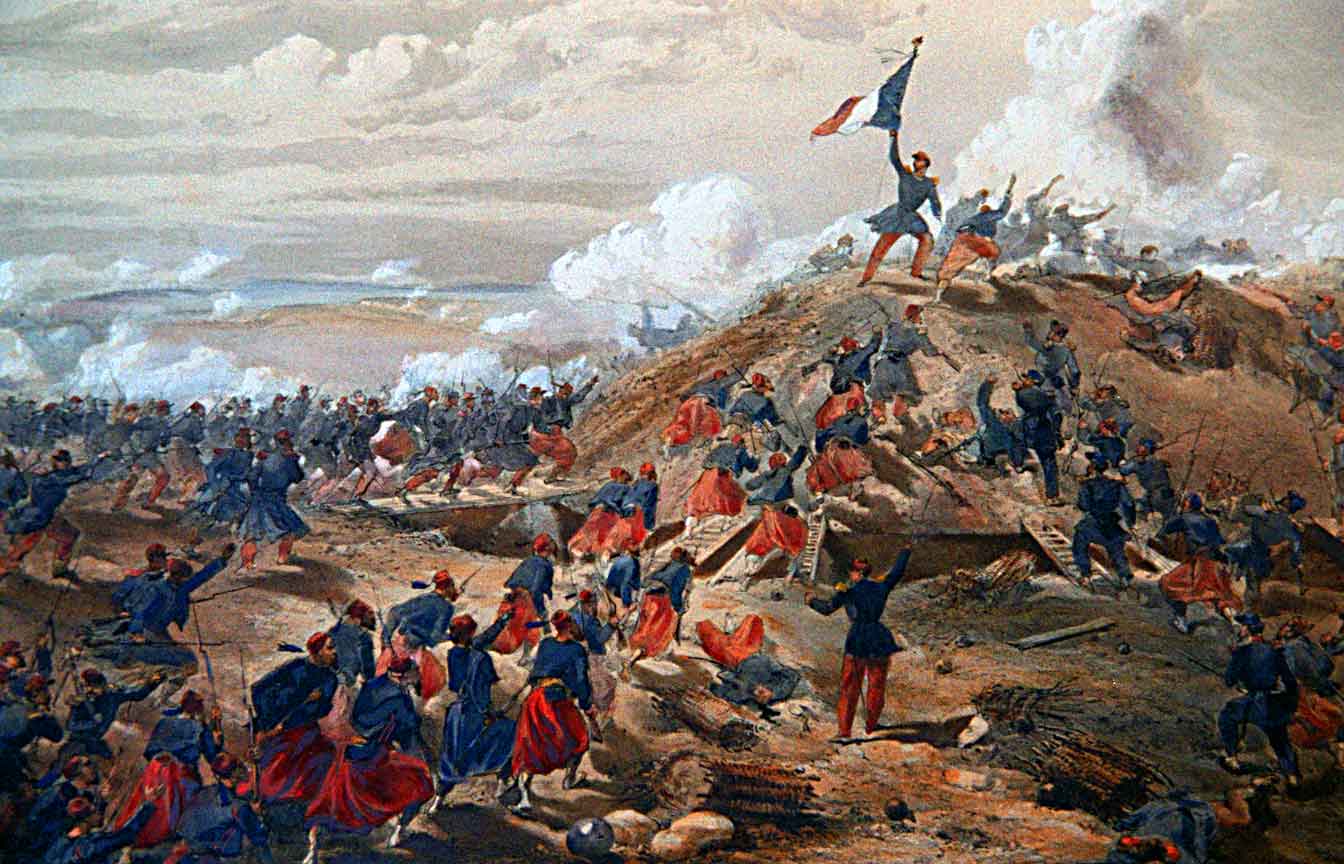The Crimean War was a struggle over supremacy in the Middle East and the Black Sea area, involving the Ottoman Empire and most of the major powers in Europe.
The war lasted for just three years, but the results of the war had long-ranging consequences for all parties involved, as well as their territories and international standing.
The Ottoman Empire had formed in the early 14th Century and gained much strength and recognition after its forces had conquered Constantinople, in 1453. The empire grew and grew, reaching its greatest extent in 1683, when its reach wrapped around the Mediterranean Sea, encompassing the following:
- all of what is now Turkey
- much of North Africa, including Egypt
- land on both sides of the Red Sea, including the sacred Islamic cities of Mecca and Medina
- the "Holy Land," including the sacred Jewish and Christian city of Jerusalem
- much of what is now Syria and Iraq
- large parts of what is now Hungary, Yugoslavia, Bulgaria, and Greece
- territory bordering both the Black Sea and the Caspian Sea.
 Russia during this time was growing in size and influence as well. Russia, historically on the lookout for a warm-water port and also looking to expand its influence around its southern borders, looked to profit from the decline of the Ottoman Empire. As Russia gained more territory to the south, the borders of Russia became shared with the Ottoman Empire.
Russia during this time was growing in size and influence as well. Russia, historically on the lookout for a warm-water port and also looking to expand its influence around its southern borders, looked to profit from the decline of the Ottoman Empire. As Russia gained more territory to the south, the borders of Russia became shared with the Ottoman Empire.
During the 18th Century and the early 19th Century, conflicts on the European mainland resulted in a redrawing of the boundaries of many empires and territories, resulting in a decline of Ottoman influence in Europe. By the mid-19th Century, Ottoman influence was still strong in the Middle East but not so much in Europe. Because of this, many historians now refer to the Ottoman Empire at this time as "the sick man of Europe."
Also at this time, a movement grew in Europe to protect the rights of Christians living in the Holy Land. A series of Crusades in the Middle Ages had failed to dislodge the area from Middle Eastern control. This more modern dispute, however, was splintered in that western Europeans, primarily in France, wanted to advance the cause of Catholic Christianity, whereas Russia wanted to advance the cause of Orthodox Christianity. (The two groups have several key differences in doctrine.)
Seeing an opportunity in the decline of strength of the Ottoman Empire, both France and Russia sought to expand their own influence in the Middle East. France sent what was then the world's most powerful ship, Charlemagne, to the Black Sea area. Russia sent troops over land, into the European lands of Moldavia and Wallachia, near the Danube River. By this time, the United Kingdom was involved as well. A series of diplomatic initiatives between the four powers did not result in a truce, and Sultan Abdülmecid I declared war on Russia on October 23, 1853.
The two powers fought a series of battles in the Caucasus region. Fighting took place near the Danube River, in Europe, as well, and this alarmed the leaders of the major powers in Europe enough to continue to seek a peace. As the land battles were going on, representatives of Austria, France, Prussia, and the U.K. met in Vienna near the end of 1853 and drafted a series of terms to which Russia agreed but the Ottoman Empire did not. Subsequent amendments pleased the Sultan but not Russian Tsar Nicholas I. So on the war went.
Russia struck a big blow at Sinope, wiping out a large part of the Ottoman fleet. This, coupled with Russia's refusal to continue to negotiate, prompted the U.K. and France to issue an ultimatum, demanding that Russian forces withdraw from the areas near the Danube. No response came from Moscow, and the U.K. and France declared war on Russia on March 28, 1854.
Fighting in the Danube region continued, with each side claiming victories. Austria, which had announced its neutrality, threatened to enter the war on the side of the Ottoman Empire and moved troops into the Danube region. In response, Russia withdrew from the area, leaving the Black Sea and Caucasus regions as the only theaters of war.
 The U.K. by this time had added naval support to French and Ottoman efforts in the Black Sea area. Russian naval efforts did not much involve battles between ships; as a result, the allied forces were able to maintain supply lines through the Dardanelles and into the Black Sea region.
The U.K. by this time had added naval support to French and Ottoman efforts in the Black Sea area. Russian naval efforts did not much involve battles between ships; as a result, the allied forces were able to maintain supply lines through the Dardanelles and into the Black Sea region.
Russia's major fortress on the Crimea Peninsula, for which the war is named, was Sevastapol. Allied forces landed there in late 1854 and eventually took the fortress, a full year later, on September 9, 1855. Forces from the Kingdom of Sardinia took part in engagements in the Black Sea region.

Siege of Sevastapol |

Charge of the Light Brigade |
The war was not over, though. The two sides continued to fight on the Crimea Peninsula. Just a few weeks later, at the Battle of Balaclava, an ambiguous order resulted in the Charge of the Light Brigade, a group of British cavalry attacking a Russian position fortified with cannons. Of the 620 horsemen who took part in the Charge, 118 did not survive the attack.
Russia's Tsar, Nicholas I, had died in February 1855. His successor, Alexander II, was more inclined to pursue a peaceful outcome. Negotiations were successful in producing a truce, in February 1856. The Treaty of Paris (one of so many of that name) was signed on March 30, 1856.
The Crimean War had political consequences felt throughout the rest of the 19th Century. First and foremost was the enmity that developed between Austria and Russia when the former forced the latter to evacuate the Danube area and then later threatened to invade Russia itself. Both powers later competed for influence in the Balkans, and the struggles there, coupled with diplomatic and military alliances, were part of the series of the events that led to the outbreak of World War I.
Despite its "victory" in the war, the Ottoman Empire did not grow much more significantly for the rest of the 19th Century. The Empire was part of the Central Powers during World War I and scored some major victories (notably at Gallipoli), but the zenith of the Empire seen in 1683 was by then a distant memory.
The Crimean War featured troops marching and sailing to far-flung destinations. Many of the battles involved troops that were badly prepared, badly supplied, and badly managed. Death tolls were higher than expected as a result.
Also contributing to the high death toll was a relative lack of medical care. Despite the advent of Florence Nightingale, deaths during the Crimean War from disease and injuries were far more than those suffered by "live fire" on the battlefields and the high seas.